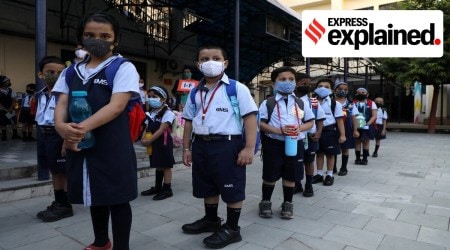A national math problem: how to teach Class 5 kids after 2 years lost
Siddharth cannot subtract 13 from 21 because this entails borrowing. Keerti can do only simple division, so 59 divided by 7 is a struggle since she hasn’t understood the concept of a remainder. Harish’s climb is steeper: he cannot identify one-digit numbers, something he should have been able to do in pre-school.
All three are 10-year-olds, students of Class 5A at the Veer Savarkar Sarvodaya Kanya Vidyalaya, a Delhi government school in Kalkaji. Each should have been fluent in these foundational mathematical skills that are taught in Class 3 or earlier. But this class of 38 children — 20 girls and 18 boys — were last in school in Class 2.
Now back after two years of a pandemic and a lockdown that touched every aspect their lives, their teacher Neha Sharma, 31, has a problem, one that teachers across the country are grappling with, highlighted by the recently released results of the National Achievement Survey (NAS): academic performances in schools across the country, including in the national capital, slipped below levels recorded in 2017, except in Punjab and Rajasthan.
Over two years of the pandemic, much of these Class 5 kids’ learning happened through weekly worksheets and activities shared on WhatsApp. But with access to devices and data uneven, digital learning remained, at best, very patchy.
So, how will Sharma meet this unprecedented challenge: bringing her class up to speed for Class 5? Given that the students have different competencies and levels of learning, how does she calibrate her teaching, at different speeds for different children?
To investigate this, The Indian Express sat in for five weeks tracking the 38 children of Class 5A right from their first day of school through each of their 26 math classes and key parent-teacher meetings.
Being their final year of primary school, Class 5 marks a crucial milestone, just one year away from middle school, the bridge to secondary. Maths was chosen since it is a subject that has traditionally challenged both students and educators alike and these challenges, experts said, were exacerbated during the lockdown.
Especially for children from economically weaker sections and working-class families, the demographic that constitutes much of Class 5A, who did not have ready access to screen devices or the Internet.
While Harish’s father is a daily-wage worker, Siddharth’s family is supported by his mother’s anganwadi job, and Keerti’s father is a fruit vendor.
Each of them brings to the classroom a unique set of challenges which Sharma has to grapple with using a range of tools: from innovative worksheets and quizzes to detailed sessions with parents, all the while playing teacher, counsellor and, often, even their friend.
Framing her challenge is the CBSE Class 5 curriculum that prescribes word problems involving addition, subtraction, multiplication and division; angles and degrees; perimeter and area; fractions; factors and multiples with LCM and HCF; measuring volume of cuboids; expressing tenths and hundredths in decimal points.
This is standard rubric for Sharma who has taught in government schools for 10 years. But this time, barely two weeks before school, at full capacity, began on April 1, it looks scary — Class 5A was nowhere near ready for it.
Indeed, Sharma had conducted a basic assessment of all the children in mid-March to understand where they stood. This is what the report card looked like:
Class 3 level: 20 of her 38 students were able to do only simple division sums which did not have remainders. Two students were able to do subtraction sums with two-digit numbers though they were not able to do simple division. Satisfactory.
Class 1 level: 14 students were not able to subtract and were put in the 10-99 category — that is, they could only identify and count numbers between 10 and 99. Bleak.
Pre-school level: One student could only identify numbers between 0 and 9, while Harish could not even do that. He had to be categorised as “beginner”. Distressing.
This baseline, that Sharma has to work with, was at the heart of the Delhi Government’s decision, when schools reopened in April, to devote the first three months of Classes 3 to 9 to foundational learning — called Mission Buniyad — and preparing to get the students to grade level, working on the assumption that most children would have fallen behind.
So, until mid-June, all children in these grades will focus on the basics of reading, writing and maths. For Class 5A and Sharma, this is the window to try and make up for lost time.
She knows it’s a long, hard journey — even those she identified as her brightest are not up to their grade level.
“Before the pandemic, if there was a class with 40 children, there would always be four to five of them who were weak but not that they didn’t know the numbers or the alphabet,” said Sharma. “That has changed now. I suspect that even by the end of the year, despite all our efforts, at least 30 per cent of the class will not be able to grasp the Class 5 syllabus. My aim is to get the children to the next grade with a working understanding of these concepts.”
With this realism tempering her hope, she gets to work.
(Names of children have been changed to protect their identities)







